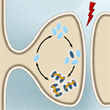Wednesday, 24 July 2013
Oligomers Help Us Keep Our Memories
 A protein whose molecules have the special ability to stack on top of one another, somewhat like egg cartons, and thus form short, highly stable chains (oligomers), may well play a key role in the mechanisms by which we maintain lasting memories.
A protein whose molecules have the special ability to stack on top of one another, somewhat like egg cartons, and thus form short, highly stable chains (oligomers), may well play a key role in the mechanisms by which we maintain lasting memories.
Indeed, there is always something magical about remembering something that you haven’t thought about in years. But physically speaking, in what form is the corresponding memory trace maintained in your brain over all that time? Neurobiologists know that the whole process occurs in the synapses (the plastic connections between neurons) and have described molecular mechanisms such as long-term potentiation that partly explain this plasticity.
But some pieces of this puzzle are still missing, in particular as regards the molecular phenomena that can withstand the ravages of time in a molecular environment that is constantly being demolished and rebuilt. However, as reported in the January 27, 2012 issue of the journal Cell, a study by Amitabha Majumdar and his research team has identified a likely mechanism behind the stability of memory traces.
This study showed that the quantity of oligomers (the stacked form) of the protein Orb2 in the neurons of the Drosophila fly increases when they are repeatedly stimulated, which simulates learning. Moreover, this increase occurs specifically in the synapses of the neurons. But the most telling manipulation by the researchers in this study was to show that in flies whose gene for the Orb2 protein has been mutated so that it cannot form oligomers, the ability to form long-term memories is lost.
The next challenge will be to show how long the Orb2 oligomers have to stay there to keep the memory trace accessible. The hypothesis is that they have to stay there forever, which they can do precisely because of their constant ability to stack on top of one another and thus keep the chain of oligomers intact over time.
This same ability is also found in other proteins that are associated with neuronal dysfunctions such as Alzheimer’s disease, in which the beta-amyloid protein occurs, as does Orb2, in two forms: one that has a strong propensity to form oligomers and another that is more inert. According to the authors of this study, Parkinson’s disease, Huntington’s disease and other diseases caused by prions, such as Creutzfeldt-Jakob disease, may also depend on the brain’s being perhaps too hospitable an environment for the formation of oligomers—a mechanism which, as we have just seen, can be highly useful in other respects.
![]() Making Memories Last: Prion-Like Protein Plays Key Role in Storing Long-Term Memories
Making Memories Last: Prion-Like Protein Plays Key Role in Storing Long-Term Memories
![]() Critical Role of Amyloid-like Oligomers of Drosophila Orb2 in the Persistence of Memory
Critical Role of Amyloid-like Oligomers of Drosophila Orb2 in the Persistence of Memory
Memory and the Brain, Mental Disorders | Comments Closed








